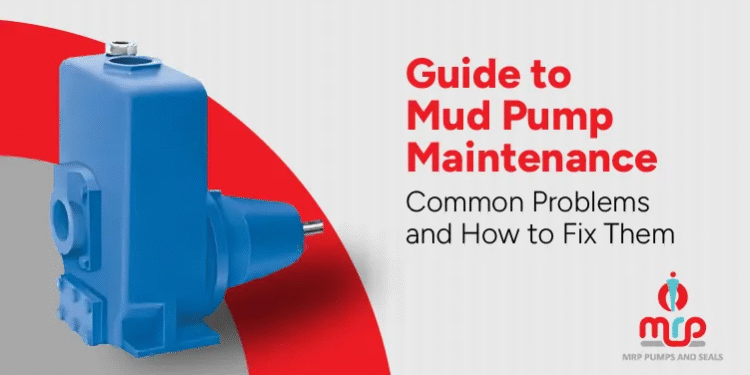A failing mud pump doesn’t just slow down your operation—it can halt an entire industrial process, costing thousands in lost production and unexpected downtime. In demanding sectors like mining, construction, and wastewater treatment, your pump is the engine of productivity. Understanding preventative mud pump maintenance is the most effective way to secure operational efficiency and safeguard your budget.
This guide from MRP Pumps, a trusted manufacturer for major industrial partners like Reliance and Tata, provides actionable solutions for the most common issues you’ll face. We’ll start with the most critical problems and move directly to expert fixes, turning your maintenance challenge into a predictable workflow.
Understanding Mud Pump Fundamentals
What are mud pumps and their applications?
Mud pumps are heavy-duty devices specifically designed to handle thick, abrasive, and high-solids-content fluids—or “slurry/mud.” They are essential for moving materials that standard pumps cannot manage without failing.
- Mining and Mineral Processing: Used for slurry transfer, tailings, and dewatering in harsh environments.
- Wastewater Treatment: Critical for moving raw sewage, sludge, and highly viscous effluent (matching the function of MRP Pumps’ Sewage Mud Pump).
- Construction and Drilling Operations: Employed for drilling mud circulation, concrete pumping, and managing site runoff.
Major components overview
Knowing your pump’s anatomy is the first step in effective mud pump maintenance. Key components bear the brunt of moving abrasive fluids.
- Impeller: The rotating component that moves the fluid; highly susceptible to wear from slurry.
- Seals (Mechanical/Gland Packing): Prevent leakage along the shaft. Failure here is a leading cause of downtime.
- Bearings: Support the rotating shaft and ensure smooth operation; wear often leads to vibration and overheating.
- Pump Casing (Volute): The outer shell that directs fluid flow; must be robust to resist abrasion and pressure.
Why regular maintenance matters
Ignoring an effective industrial pump maintenance guide is a direct path to costly emergency repairs. Preventative care ensures system reliability.
- Cost Savings vs. Replacement: Routine slurry pump service is far cheaper than replacing a failed unit or managing catastrophic component failure.
- Operational Efficiency: Well-maintained pumps run at their rated efficiency, conserving energy and maintaining consistent flow.
- Safety Considerations: Preventative measures reduce the risk of structural failure, leakage, or dangerous overheating on the job site.
Problem #1: Mud Pump Won’t Start (Immediate Troubleshooting)
When the pump is needed most and fails to engage, the cause is often immediate and fixable.
Causes:
- Power Supply Issues: Voltage fluctuations, blown fuses, or phase loss in the electrical line are common culprits.
- Mechanical Failures: Seized bearings, damaged seals, or severe misalignment preventing shaft rotation.
- Blockages: Large debris lodged between the Impeller and casing, particularly common for a Sewage Mud Pump.
- Corrosion: Rusted components (shaft, bearings, seals) that seize the assembly over time.
Solutions:
- Electrical Troubleshooting: Immediately check all power connections, verify fuses, and confirm voltage levels match the motor specifications.
- Mechanical Inspection: Disassemble the pump end for visual inspection. Clean debris and remove rust using appropriate solvents or gentle abrasion.
- Component Replacement: If the bearings or seals are seized, they must be replaced immediately. MRP Pumps provides high-quality Pump Spare Parts & Components for rapid repair.
- Preventive Measures: Implement a regular inspection schedule for electrical connections and lubricate bearings promptly to prevent seizure.
Problem #2: Insufficient Flow Rate (Low Output)
Causes:
- Impeller Clogging: Debris, rags, or sediment buildup within the impeller vanes (a particularly common issue for a Sewage Mud Pump handling heavy mud or sewage).
- Air Leakage/Cavitation: Leaks in the suction (inlet) pipes, pulling air into the system, or insufficient Net Positive Suction Head available (NPSHa) causing true vaporization (cavitation).
- Incorrect Pump Speed: Belt slippage, worn couplings, or motor problems causing the pump to operate below its design speed.
- Worn or Damaged Impeller: Abrasive fluids constantly erode the impeller vanes, reducing its ability to generate momentum.
Solutions:
- Impeller Maintenance: Shut down and perform regular cleaning to remove clogs. Inspect the impeller for signs of excessive wear (often termed “wearing thin” in the industry).
- Pipeline Optimization: Check all inlet pipes and connections for air leaks. Replace faulty gaskets or tighten flange bolts immediately. Verify NPSHa to ensure the pump is not operating in a true cavitation regime.
- Speed Adjustment: Check the motor speed and adjust belt tension or replace worn belts to ensure the pump runs at its rated RPM.
- System Modifications: If the pump is operating under high suction lift conditions, consider lowering the installation position or shortening the pipeline to improve intake.
Problem #3: Insufficient Pressure Output
Low pressure means the pump cannot push the fluid to the required height or distance, causing critical process failure.
Causes:
- Severe Impeller Wear: Erosion significantly increases the clearance between the Impeller and the casing, causing fluid recirculation and reducing efficiency.
- Inlet Pipe Blockages: Any restriction in the suction line will starve the pump, making it unable to generate design pressure.
- Damaged Seals: Leaky seals cause severe internal leakage, reducing the effective pressure output.
- Worn Wear Rings: These replaceable rings maintain a tight seal between the rotating and stationary elements. Excessive wear allows high-pressure fluid to leak back to the suction side.
Solutions:
- Impeller Replacement: Consult MRP Pumps’ Technical Consultation services to determine if Impeller wear requires replacement. This is vital for slurry pump service.
- Seal System Overhaul: Replace all damaged seals, gaskets, and O-rings. Ensure proper gland packing adjustment if applicable.
- Motor Diagnostics: Verify the motor is delivering its rated power and speed to the pump shaft.
- Clearance Adjustment: If possible, set proper tolerances between wear rings and the Impeller to minimize fluid recirculation.
Problem #4: Excessive Vibration
Excessive vibration is a clear warning signal. If left unaddressed, it leads quickly to catastrophic bearing lubrication schedule failure and component damage.
Causes:
- Impeller Imbalance: Uneven wear from abrasive fluids or damage (e.g., a missing vane piece) causes the Impeller to spin off-center.
- Bearing Failure: Worn bearings allow excessive shaft movement. This is often the secondary result of poor bearing lubrication schedule adherence.
- Misalignment: The motor and pump shafts are not perfectly aligned, creating severe stress on bearings and couplings.
- Inadequate Foundation: The baseplate or foundation is weak, causing the entire assembly to shake during operation.
Solutions:
- Dynamic Balancing: The Impeller must be removed and sent for a professional dynamic balancing service to correct weight distribution.
- Bearing Replacement: Immediately replace faulty bearings and confirm the lubricant is clean and at the correct level.
- Alignment Correction: Use precision laser alignment tools (or dial indicators) to ensure perfect coaxial alignment between the motor and pump shafts.
- Foundation Reinforcement: Secure all mounting bolts and ensure the baseplate is properly grouted and level on a solid foundation.
Problem #5: Pump Overheating
Overheating, particularly in the bearings or pump casing, is a sign of severe internal friction or a lack of cooling.
Causes:
- Bearing Issues: Inadequate or contaminated bearing lubrication schedule. Bearings running dry cause massive friction and heat.
- Motor Overload: The pump is trying to push against system restrictions (e.g., a partially closed valve) beyond its design limit, overloading the motor and generating heat.
- Seal Wear: Friction from badly seated or dry seals generates heat at the shaft sleeve.
- Poor Ventilation: Especially for air-cooled pumps, lack of airflow around the motor can cause thermal shutdown.
Solutions:
- Bearing Service: Replace any damaged bearings and adhere strictly to the recommended bearing lubrication schedule.
- Load Analysis: Check discharge pressure against manufacturer specifications. Open discharge valves fully to reduce resistance if necessary.
- Cooling System Maintenance: For Thermal Hot Oil Pump / Water Cooled Pump systems, clean heat exchangers and verify coolant flow to the seals and bearings.
- Ventilation Improvement: Ensure the motor is not covered and has adequate clearance for airflow.
Ready to prevent costly pump failures? Get maintenance consultation from MRP Pumps today and protect your industrial operations. Contact us now!
Preventive Maintenance Best Practices
The core of effective mud pump maintenance is a standardized, proactive schedule.
| Schedule | Action Items | Purpose |
| Daily Checks | Visual inspection for leaks, noise, or vibration. Monitor operating pressure and temperature. Check lubrication levels. | Catch early signs of failure and prevent rapid deterioration. |
| Weekly Maintenance | Clean inlet screens and remove debris. Inspect seals/gland packing for excessive drip/leakage. | Maintain optimum flow and prevent cavitation/clogging. |
| Monthly Service | Comprehensive bearing lubrication (as per schedule). Impeller and wear plate inspection for excessive erosion. Tighten all mounting bolts and electrical connections. | Ensure smooth rotation, prevent vibration, and track component wear life. |
| Annual Overhaul | Complete disassembly and inspection. Replace wear components (impeller, wear rings, seals) proactively. Professional alignment service. | Restore factory-level efficiency and prevent unexpected failures during peak seasons. |
When to Call MRP Pumps & Seals Professionals
While your internal team handles routine checks, specialized expertise is required for complex issues or system optimization. Do not attempt major mechanical repairs without the proper tools.
- Complex Repairs: For issues like shaft replacement, re-grouting the baseplate, or major pump component spare parts installation.
- Performance Optimization: If you require a system slurry pump service analysis to improve mud pump efficiency beyond simple fixes, call for Technical Consultation.
- Upgrade Consultation: When facing recurring failures, consult MRP Pumps to determine if you need an upgrade to a different pump type (e.g., from a Centrifugal Process Pump to a Slurry Pump or Progressive Cavity Screw Pump) or a custom solution.
Conclusion
Effective mud pump maintenance is not an expense—it is a mandatory investment in operational continuity and efficiency. By following this guide, focusing on a robust maintenance schedule, and addressing issues like impeller wear analysis and bearing lubrication schedule promptly, you significantly reduce the risk of downtime.
Action Items: Immediately implement the Daily and Weekly checks detailed above and schedule your Annual Overhaul.
MRP Pumps is committed to the long-term success of your operations. Our quality products, backed by comprehensive Installation & Maintenance Services and a full stock of Pump Spare Parts & Components, ensure your equipment runs reliably. We provide the expertise your team needs for successful sewage mud pump repair and slurry pump service.
Contact us today for expert consultation and comprehensive pump solutions tailored to your specific requirements.
Frequently Asked Questions (FAQs) about Mud Pump Maintenance
The main signs are a noticeable drop in the pump’s flow rate and pressure output, along with increased vibration. Worn impellers lead to excessive fluid recirculation and reduced efficiency, requiring an impeller wear analysis and replacement.
The frequency depends on the bearing type, environment, and pump use, but most require lubrication monthly or quarterly. Always follow the manufacturer’s recommended bearing lubrication schedule to prevent overheating and premature failure.
Cavitation occurs when vapor bubbles form and collapse inside the pump, often due to low pressure at the suction side. Prevent it by checking the suction line for blockages or air leaks, ensuring the pump runs at the correct speed, and keeping suction lift as low as possible.
Yes. Excessive vibration often signals bearing failure, Impeller imbalance, or shaft misalignment. Regular vibration monitoring is a critical mud pump troubleshooting step that catches minor issues before they cause catastrophic failure and require expensive pump component spare parts.
The most common cause of leakage is worn or damaged seals (gland packing or mechanical seals) along the pump shaft. Immediate replacement of seals is necessary to prevent internal component damage and ensure compliance.





